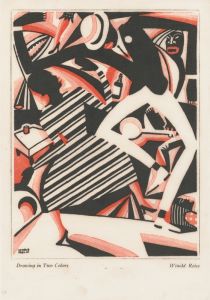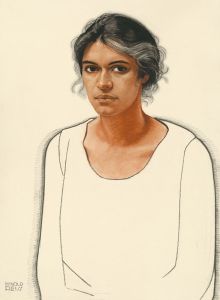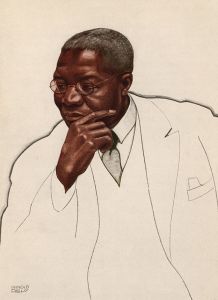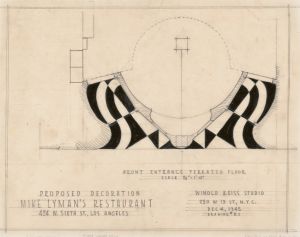
Miscellaneous small sketches for inlaid table tops.] [Design with zig-zag motif
A hand-painted replica of Winold Reiss’s masterpiece Miscellaneous small sketches for inlaid table tops.] [Design with zig-zag motif, meticulously crafted by professional artists to capture the true essence of the original. Each piece is created with museum-quality canvas and rare mineral pigments, carefully painted by experienced artists with delicate brushstrokes and rich, layered colors to perfectly recreate the texture of the original artwork. Unlike machine-printed reproductions, this hand-painted version brings the painting to life, infused with the artist’s emotions and skill in every stroke. Whether for personal collection or home decoration, it instantly elevates the artistic atmosphere of any space.
Winold Reiss was a German-American artist and designer known for his contributions to modern design and his role in popularizing the use of vibrant colors and geometric patterns in the early 20th century. Born in 1886 in Karlsruhe, Germany, Reiss immigrated to the United States in 1913, where he became a significant figure in the American art scene. His work spanned various media, including painting, graphic design, and interior decoration.
Reiss's artistic style was heavily influenced by his European training and his exposure to different cultures. He studied at the Royal Academy of Fine Arts in Munich, where he was influenced by the Jugendstil movement, a German counterpart to Art Nouveau. This background informed his later work, which often featured bold colors and intricate patterns.
The piece titled "Miscellaneous small sketches for inlaid table tops" and "Design with zig-zag motif" reflects Reiss's interest in decorative arts and his skill in creating designs that were both functional and aesthetically pleasing. Although specific details about these particular sketches are limited, they are indicative of Reiss's broader body of work, which often included designs for furniture, textiles, and interiors.
Reiss was particularly known for his innovative use of color and pattern. His designs frequently incorporated geometric motifs, such as zig-zags, which were characteristic of the Art Deco movement that gained popularity in the 1920s and 1930s. This style was marked by its emphasis on modernity, luxury, and exuberance, often featuring symmetrical and streamlined forms.
In addition to his work in design, Reiss was also a prolific portrait artist. He is perhaps best known for his portraits of Native Americans and African Americans, which he created with a deep sense of respect and admiration for his subjects. His portraits were notable for their vivid colors and attention to detail, capturing the individuality and dignity of each person.
Reiss's work in design extended to his involvement in various public and commercial projects. He was commissioned to create murals and interior designs for several notable buildings, including the Cincinnati Union Terminal and the Hotel St. George in Brooklyn. These projects allowed him to bring his unique artistic vision to a wider audience and solidify his reputation as a leading designer of his time.
Throughout his career, Reiss remained committed to the idea that art should be accessible and integrated into everyday life. His designs for inlaid table tops and other decorative objects exemplify this philosophy, as they were intended to enhance the beauty and functionality of everyday items.
Winold Reiss's legacy continues to be celebrated for its contributions to modern design and its role in bridging cultural and artistic boundaries. His work remains an important part of the history of American art and design, reflecting a period of dynamic change and innovation.






![Design for dčor of restaurant, 56 East 56th St, New York, NY.] [Drawing of suggested dčor for restaurant with color elevation and murals](/imgs/249282/s/winold-reiss-design-for-dcor-of-restaurant-56-east-56th-st-new-york-ny-drawing-of-suggested-dcor-for-restaurant-with-color-elevation-and-murals-29535340.jpg)
![Designs for lamps with triangular shades.] [Design with white, red, and metallic silver](/imgs/249315/s/winold-reiss-designs-for-lamps-with-triangular-shades-design-with-white-red-and-metallic-silver-40bb661.jpg)
![Designs for staged commercial or trade exhibition displays of coal-fired water heaters and furniture.] [Perspective sketch featuring flames](/imgs/249323/s/winold-reiss-designs-for-staged-commercial-or-trade-exhibition-displays-of-coalfired-water-heaters-and-furniture-perspective-sketch-featuring-flames-367ef0b8.jpg)

![Design sketches for stepped, three-panel, painted decorative folding screens.] [Drawing of plans, elevation, and details](/imgs/249416/s/winold-reiss-design-sketches-for-stepped-threepanel-painted-decorative-folding-screens-drawing-of-plans-elevation-and-details-cebab690.jpg)

![Miscellaneous small sketches for inlaid table tops.] [Design with blue circular motif](/imgs/249432/s/winold-reiss-miscellaneous-small-sketches-for-inlaid-table-tops-design-with-blue-circular-motif-ed1ccdfe.jpg)
![Miscellaneous small sketches for inlaid table tops.] [Design with circular and geometric motif](/imgs/249433/s/winold-reiss-miscellaneous-small-sketches-for-inlaid-table-tops-design-with-circular-and-geometric-motif-3afe4da6.jpg)
![Miscellaneous small sketches for inlaid table tops.] [Design with red geometric motif](/imgs/249442/s/winold-reiss-miscellaneous-small-sketches-for-inlaid-table-tops-design-with-red-geometric-motif-c586b6d.jpg)


